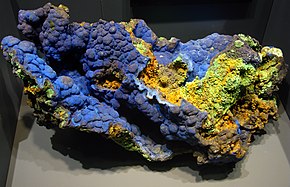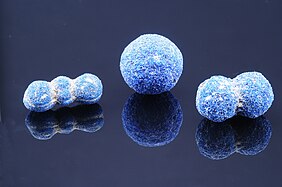Azurite
| Azurite | ||
|---|---|---|
2V angle Measured: 68°, calculated: 64° | | |
| Dispersion | relatively weak | |
| References | [2][3][4] | |
Azurite is a soft, deep-blue copper mineral produced by weathering of copper ore deposits. During the early 19th century, it was also known as chessylite, after the type locality at Chessy-les-Mines near Lyon, France.[3] The mineral, a basic carbonate with the chemical formula Cu3(CO3)2(OH)2, has been known since ancient times, and was mentioned in Pliny the Elder's Natural History under the Greek name kuanos (κυανός: "deep blue," root of English cyan) and the Latin name caeruleum.[5] Copper (Cu2+) gives it its blue color.[6]
Mineralogy

Azurite has the formula Cu3(CO3)2(OH)2, with the copper(II)
ion for the hydroxide anion HO−
.[8]
Azurite crystallizes in the
Azurite has a
Color
The optical properties (color, intensity) of minerals such as azurite and malachite are characteristic of copper(II). Many coordination complexes of copper(II) exhibit similar colors. According to crystal field theory, the color results from low energy d-d transitions associated with the d9 metal center.[11][12]
Weathering
Azurite is unstable in open air compared to malachite, and often is pseudomorphically replaced by malachite. This weathering process involves the replacement of some of the carbon dioxide (CO2) units with water (H2O), changing the carbonate:hydroxide ratio of azurite from 1:1 to the 1:2 ratio of malachite:[7]
- 2 Cu3(CO3)2(OH)2 + H2O → 3 Cu2(CO3)(OH)2 + CO2
From the above equation, the conversion of azurite into malachite is attributable to the low partial pressure of carbon dioxide in air.
Azurite is quite stable under ordinary storage conditions, so that specimens retain their deep blue color for long periods of time.[13]
Occurrences

Azurite is found in the same geologic settings as its sister mineral, malachite, though it is usually less abundant. Both minerals occur widely as
Fine specimens can be found at many locations. Among the best specimens are found at Bisbee, Arizona, and nearby locations, and have included clusters of crystals several inches long and spherical aggregates and rosettes up to 2 inches (51 mm) in diameter. Similar rosettes are found at Chessy, Rhône, France. The best crystals, up to 10 inches (250 mm) in length, are found at Tsumeb, Namibia. Other notable occurrences are in Utah; Mexico; the Ural and Altai Mountains; Sardinia; Laurion, Greece; Wallaroo, South Australia; Brazil and Broken Hill.[10]
Uses
Pigments
Azurite is unstable in air, however it was used as a
Heating can be used to distinguish azurite from purified natural
Azurite pigment can be synthesized by precipitating copper(II) hydroxide from a solution of copper(II) chloride with lime (calcium hydroxide) and treating the precipitate with a concentrated solution of potassium carbonate and lime. This pigment is likely to contain traces of basic copper(II) chlorides.[19]
-
Ground azurite for use as a pigment
-
The background of Lady with a Squirrel by Hans Holbein the Younger was painted with azurite
-
The greenish tint of the Madonna's mantle in Raphael's Madonna and Child Enthroned with Saints is due to azurite weathering to malachite
Jewelry
Azurite is used occasionally as beads and as
Collecting
The intense color of azurite makes it a popular collector's stone. The notion that specimens must be carefully protected from bright light, heat, and open air to retain their intensity of color over time may be an urban legend. Paul E. Desautels, former curator of gems and minerals at the Smithsonian Institution, has written that azurite is stable under ordinary storage conditions.[13]
Prospecting
While not a major ore of copper itself, the presence of azurite is a good surface indicator of the presence of weathered copper sulfide ores. It is usually found in association with the chemically similar malachite, producing a striking color combination of deep blue and bright green that is strongly indicative of the presence of copper ores.[7]
History
Azurite was known in the pre-classical
Gallery
-
Azurite crystals from China
-
Azurite from Arizona, collected by Dr John Hunter in the 18th century, Hunterian Museum, Glasgow
-
Fresh, unweathered azurite crystals showing the deep blue of unaltered azurite. From Špania Dolina, Slovakia
-
Azurite with Malachite, Copper Queen mine, Bisbee, Arizona
-
Azurite from Touissit, Morocco
-
Azurite, Morenci, Arizona
-
Azurite in siltstone, Malbunka mine, Northern Territory, Australia
-
Azurite from Tsumeb, Namibia
-
Azurite, cross-section through merged stalactites, Bisbee, Arizona
-
Azurite from Bandung, Indonesia
-
Azurite crystal, from the minerals' collection at the Natural History Museum, London.
-
Spheroidal azurite specimens from Utah
See also
References
- S2CID 235729616.
- ^ Handbook of Mineralogy
- ^ a b c Mindat.org
- ^ a b Webmineral.com Webmineral Data
- ^ The Ancient Library: Smith, Dictionary of Greek and Roman Antiquities, p.321, right col., under BLUE Archived December 20, 2005, at the Wayback Machine
- ^ "Minerals Colored by Metal Ions". minerals.gps.caltech.edu. Retrieved 2023-03-01.
- ^ ISBN 047157452X.
- ISBN 9780750659246.
- S2CID 95738208.
- ^ ISBN 0442276249.
- ^ Nassau, K. (1978). "The origins of color in minerals". American Mineralogist. 63 (3–4): 219–229.
- ^ Klein & Hurlbut 1993, pp. 260–263.
- ^ .
- ^ Gettens, R.J. and Fitzhugh, E.W., Azurite and Blue Verditer, in Artists’ Pigments. A Handbook of Their History and Characteristics, Vol. 2: A. Roy (Ed.) Oxford University Press 1993, p. 23–24
- ISBN 978-0521452571.
- ISBN 0-8317-7739-7
- .
- .
- JSTOR 1505860.
- S2CID 219714562.
- ISBN 9781402768293. Retrieved 18 September 2021.
- OCLC 312267983.
- ISBN 0924171952.
External links
- Spencer, Leonard James (1911). . Encyclopædia Britannica. Vol. 3 (11th ed.). p. 86.
- Azurite, Colourlex















